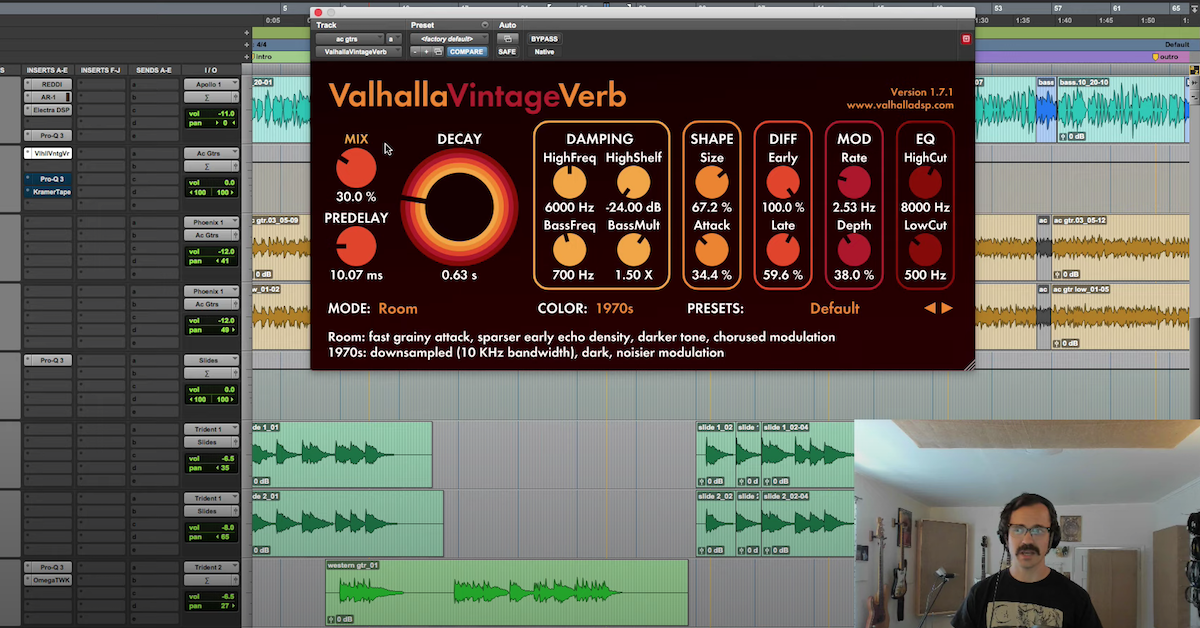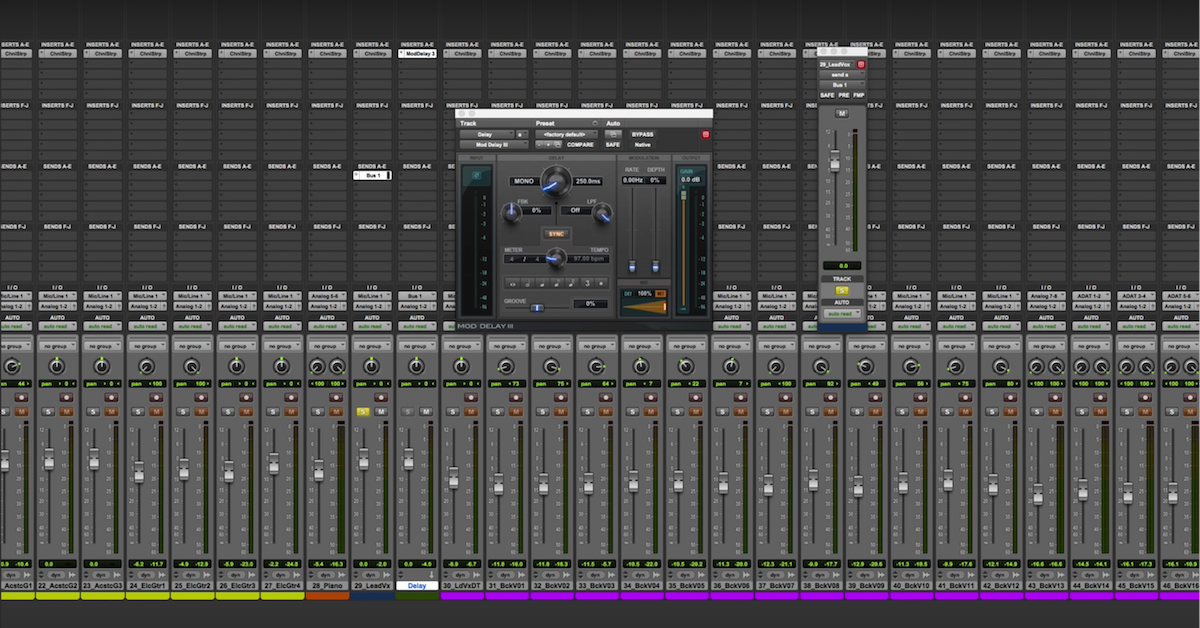4 Tips For Doubling Instruments (+ 3 Pitfalls To Avoid)
Article Content
Doubling parts in an arrangement can be a great way to add excitement to a track. Whether doubling a lead vocal, stacking electric guitars, or combining layers of synths and samples, doubles can make productions sound bigger and more energetic, and bring stale sounding parts to life.
As with any production technique, the best way to double instruments can vary from one scenario to another. I find that a great place to start when making mix and production choices is first to ask yourself what the intended effect is. Here are four ways doubling can help enhance your tracks:
1. Double for Width
This is probably the most straightforward reason to double a track, and chances are that you have already tried something like what I’m about to describe. Doubling a part to make it feel wider is often as simple as taking two takes of a part and panning them left and right. Essentially, a part that would otherwise be a mono element in your arrangement becomes bigger and wider, giving it a stereo feel.
Performances of the doubled part should be very similar, but not exact. If they’re too close, you might not notice the double; if they’re too different then you may end up obscuring the part. If width is the only goal, then the tone of the two parts should stay fairly similar. They are effectively functioning as one instrument.
If you’re doubling a part in this way, process the doubles together: EQ, compression and gating, reverb and delay — process the parts so they live and breathe together.
Listen to the rhythm guitars in the verse of The Velvet Underground’s “Sweet Jane.” Though one is an acoustic (left) and the other electric (right), the two are similar enough and combine to become one shimmering, stereo instrument. The arrangement is sparse, and this simple trick helps accentuate what would otherwise be a relatively unremarkable part.
2. Double for Movement
This concept is sort of a cousin of doubling for width, and if you kept listening through to the chorus in the first example, you’ve already heard it in action. The idea here is that you can take two parts that are similar but not exactly the same and pan them so that the listener’s attention moves between the two. Unlike doubling a part simply to make it wider, this technique also works well with instruments that are more tonally diverse.
Additionally, greater rhythmic variation between the parts will intensify the sense of movement. Try splitting one busy idea into two simpler, interlocking lines. Pan them wide to turn what would have been an unremarkable rhythmic element into something exciting that our ears want to gravitate toward.
These doubled elements should still be processed together, but be careful not to overdo the buss compression. Aggressively dialed compressors can end up masking the double, obscuring the effect you’re trying to create. As in the example from the previous point, it can also be effective for doubles to alternate between being more and less rhythmically exact with each other to get an even more varied effect out of a relatively simple trick.
3. Double for Weight
Another great use of doubling is adding weight to instruments by stacking them with doubles with complementary frequency content. If the original sound feels thin, pair it with a double that helps add body; if it feels muddy or indistinct, layer a sound that adds definition and air.
A great example of this concept is using synth tones to bolster thin feeling chordal instruments like guitars and keys. A synth with the right grit and heft layered behind an electric guitar can make it sound more robust and present, adding harmonics that aren’t present in the original signal. If it’s mixed properly, the average listener probably won’t recognize that they’re hearing anything other than an electric guitar. Properly tuned, synth tones can even be blended to add heft to drums — especially kick and snare.
A more organic example of the same idea is to stack a take of chords on a piano or guitar with a second take of the same chords played in different inversions (using a capo, for example). If you can match the performance closely, you end up with beefy, king-size chords.
When aiming to add weight, whether and how to pan the doubles is somewhat situational. It is certainly possible to add both width and weight with a double. If each of the doubles can stand on its own reasonably well — think different inversions of guitar or keyboard chords — panning wide might work very well. If there is clearly one “dominant” layer, secondary layers will work best panned with the main one. Expect to buss and process these layers together for best results.
Listen to the enormous chords that crash through Jay Z’s “99 Problems.” The sound is a combination of many layers of sampled and newly recorded guitars. Individually, each layer may sound ordinary (or even bad!), but together they’re larger than life.
https://vimeo.com/306702374
4. Double for Depth
The concept of “depth” in a mix can be somewhat elusive, but a simple way to define it would be a sense of foreground and background. Doubling parts to achieve greater depth is in some ways similar to doubling them to add weight, with the distinction that depth is often achieved by accentuating the difference in tones between doubled parts rather than trying to unify them.
Playing a part on an instrument with a fast attack and little sustain and doubling it on an instrument with a slower attack and more sustain can create the feeling that each note evolves as it’s played. Pan those instruments differently and you get the sense that a single tone moves through space, across the stereo field. Try playing a melody on one instrument, then double it an octave above. Drench the higher double in stereo reverb, and hear the sense of a tight mono foreground and surreal stereo background.
While some layers may be processed individually, it may still be best to apply effects like EQ and compression at the buss level to ensure that the parts “breathe” together and don’t overcrowd frequencies that may mask other parts.
Doubled parts creating a sense of depth can be heard all over Sheila E’s “A Love Bizarre” (composed and performed with more than a little help from Prince). Listen to how the tight sax melody in the intro interacts with the slower synth doubling it. Sheila and Prince then take over that melody, layering voices singing across multiple octaves, panned left right and center, some wet and distant, others dryer and close. The synth from the intro continues on the part, adding nuance and movement.
There are, however, some easy traps to fall into when doubling instruments. Here are some tips to avoid common doubling pitfalls:
1. Don’t Just Double Everything
Most of us have been here before: you get an idea to double a part — a vocal line, a rhythm guitar part, a shaker — and it sounds great! It sounds so great that you decide to double some other instruments, and then they sound great too! Pretty soon nearly every track in the session is doubled … and all those tracks that sounded so cool and huge doubled have added up to a mix that sounds flat and lifeless. What happened?
Remember that building an effective arrangement and mix is all about context. If everything in your song is very wide, then nothing will stand out as feeling especially wide. If everything has extra weight, parts may compete for space. Listen back to the examples used in this article and try to pick out what’s doubled and what isn’t.
2. Don’t Double In Extreme Low Frequencies
It is not uncommon to hear kick tones built by stacking layers, or for secondary bass parts to enter for sections of a song that need a dynamic boost. However, those doubles rarely reinforce extreme low frequencies — down below 120 Hz or so, where the fundamental tones of basses and kick drums live. Usually, only one layer will offer any real bass frequency weight. Additional layers may help accentuate the snap of a kick or add buzz and air to a synth bass. Getting a single kick drum and a single bass to cooperate is often enough of a struggle on its own. Don’t complicate things for yourself by multiplying those problems.
3. Don’t Vary Too Far from the Part Being Doubled
I’ve discussed some ways that having variety in the performance of doubled parts can get great results. By all means, you should experiment with varying the rhythm, tone, and even pitch of your doubles. Straying too far, though, can create a new, unique part that competes with the original. Maybe the arrangement needs that new part — but it won’t function as a double.
Hopefully, these suggestions have given you some ideas about adding doubles to your tracks. Obviously, there are many more possibilities than what I’ve laid out here! Changing the tone, performance, and processing of your doubles can yield greatly varying results. Don’t shy away from experimentation and tweaking while you find what works for you. The important thing is to have a clear idea of what your goals are. It’s hard to know if a sonic experiment is a success if you don’t first know what success looks like. Happy doubling!
Acoustic Guitar Doubling Tutorial









